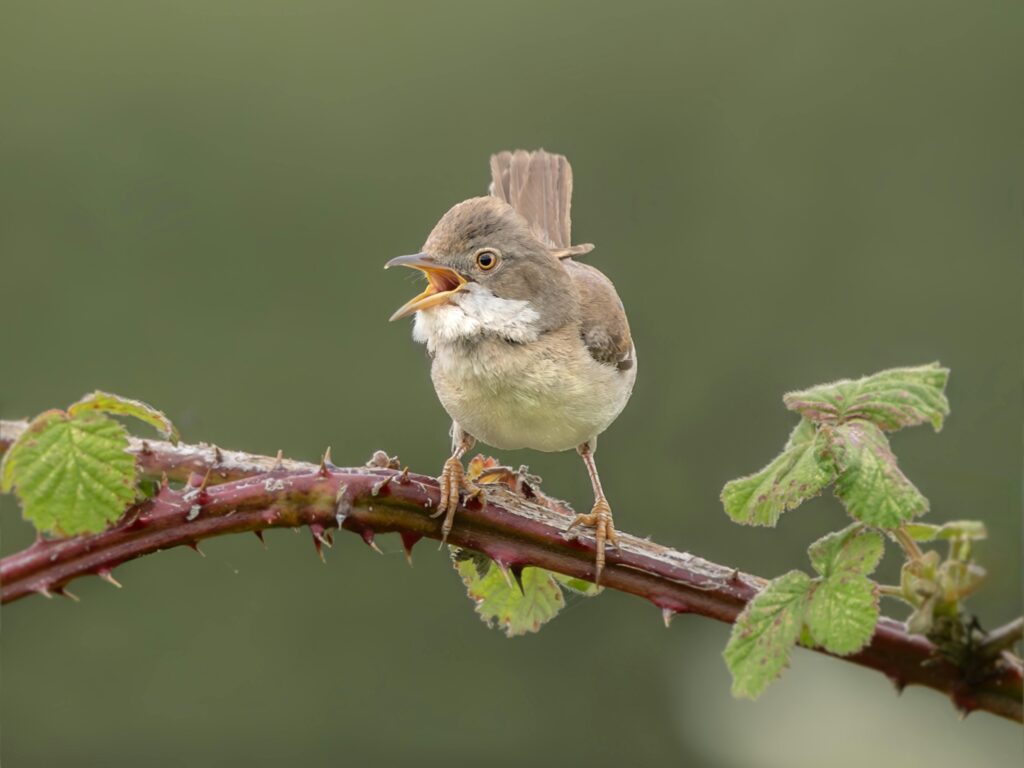
What is a syrinx? It is the organ that birds use to produce sounds and their birdsong.
Birds make sound in a different way to us. We use our larynx and they use their syrinx. Both of these words have come from Greek and larynx means “upper windpipe” and syrinx means “pan pipe”. The larynx and the syrinx work in different ways. The larynx is halfway down the neck, at the top of the windpipe. It makes sound with folds on each side of its walls. These folds are made of muscle and tissue and they are able to move. We can open and close the ventricular folds, making the gap between them larger or smaller. When we breathe out, the air passes through the larynx and makes the ventricular folds vibrate. By changing their position, we can change the pitch of the sound we make. Then we can use our tongue and lips to make the sounds more complex. The larger the larynx, the deeper the voice, which is why men usually have deeper voices than women. All mammals have this set up and they can all make complex sounds. The dexterity of their tongues and lips, plus the lack of language ability in their brains, are the only things stopping them from talking. The larynx also has a secondary job. It has a lid on top that closes when we swallow to prevent food and liquid going into our lungs. This lid is called the epiglottis.
Birds have a larynx, but they don’t use it to make sounds. They have a syrinx. The syrinx is much lower than our larynx. It is located just above where the windpipe splits to feed each lung. It is also much smaller than our larynx, although that makes sense when you consider the size of a bird. The syrinx has an air sac in the middle, just above the place where the windpipe splits into two. The sides of the syrinx are membranes that can stretch and vibrate. They are connected to cartilage to keep them in shape and also to muscles, which can control their shape. There are between five and nine muscles to control these membranes, depending on the size of the bird. When air comes out of the bird’s lungs, it makes these membranes vibrate, which is amplified, producing sound. The bird can use its muscles to change the tension on the membranes and change the pitch of the sound. They can also change the size of the openings into the lungs. They can increase the volume by increasing the airflow and they can change the sound more by using their throat and their mouth. This allows them to make a lot of sounds, but the really amazing thing is that they control both sides of the syrinx independently. That means they can make one sound with the left side and a completely different sound with the right side. That is why birds are able to make some of the beautiful sounds we hear in the morning.
Another amazing thing that birds can do with their syrinx is they can sing while they breathe in as well. This means, many birds are able to keep up a constant sound because the membranes in their syrinx vibrate when the air is coming in and when it is going out. We can make sounds when we breathe in, but it is very difficult. Give it a try. How did you do? It is very difficult for us because our larynx is open when we breathe in and we cannot easily control the rate of the air we are breathing in. Also, our larynx is closer to the top of our windpipes, which makes it too short to slow the air down enough to make sound. We can make a continuous sound by using circular breathing and some kind of musical instrument, but we cannot do it with our larynxes. Birds can. Some birds have been observed singing for 20 minutes without pausing.
And yet another amazing thing is the efficiency of the syrinx. When we speak, about 10% of the air we breathe out makes the ventricular folds in our larynx vibrate and the rest of the air just passes straight through. Birds have a much smaller windpipe and they can control it in such a way that they use almost 100% of the air to make sounds.
The fact that birds do have a larynx but don’t use it, only making sounds with their syrinx, is a very interesting mystery. Scientists don’t know if they lost the use of their larynx at some point millions of years ago and evolved a syrinx to make sounds with or if they used their larynx and syrinx at the same time, but the larynx slowly fell out of use. There are many different theories for why this happened, but the most likely one seems to be that the syrinx is more efficient and allows for prolonged singing. This would have helped any bird with this mutation attract a mate and ensures its survival. And this is what I learned today.
Photo by Mark A Jenkins: https://www.pexels.com/photo/common-whitethroat-bird-on-branch-26063324/
Sources
https://ornithology.com/the-science-of-the-syrinx
https://www.jsg.utexas.edu/news/2018/09/birds-reinvent-voice-box-in-novel-evolutionary-twist
https://www.science.org/content/article/bird-voice-box-one-kind-animal-kingdom
https://web.stanford.edu/group/stanfordbirds/text/essays/Bird_Voices.html
https://en.wikipedia.org/wiki/Syrinx_(bird_anatomy)
https://www.ncbi.nlm.nih.gov/books/NBK534630
https://www.discoverwildlife.com/animal-facts/birds/how-do-birds-sing
